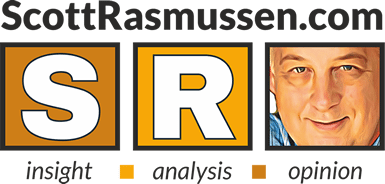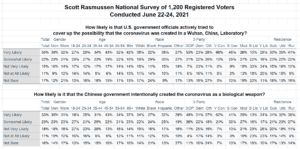Fifty-seven percent (57%) of voters think it’s likely that U.S. government officials actively tried to cover-up the possibility that the coronavirus was created in a Wuhan, China, Laboratory. A Scott Rasmussen national survey found that 26% consider it unlikely and 17% are not sure.
That total includes 35% who say it’s Very Likely and 11% who think it’s Not at All Likely.
Seventy-four percent (74%) of Republicans consider a cover-up to be at least somewhat likely. Independent voters, by a 52% to 22% margin, tend to agree. Democrats are more evenly divided: 45% believe U.S. government officials actively engaged in a cover-up while 39% disagree.
The survey also found that 56% of all voters think it’s likely that the Chinese government intentionally created the coronavirus as a biological weapon. Twenty-nine percent (29%) disagree and 16% are not sure.
Nearly two-thirds of Republicans (64%) think it’s likely that the coronavirus was developed intentionally. Independent voters, by a 45% to 30% margin agree. Democrats are evenly divided: 43% say it’s likely the virus was intentionally created as a virus while 42% consider that unlikely.
An earlier survey found that just 9% of voters believe journalists were right to dismiss the possibility of a lab lead theory. A plurality of voters believe the media rejected the theory because Donald Trump had suggested it.
Regardless of intent, 66% of voters think it’s likely the coronavirus originated in a Wuhan, China laboratory.
SIGN UP to receive Scott’s free email newsletter.
CHECK OUT Scott’s latest polls.
Note: Neither Scott Rasmussen, ScottRasmussen.com, nor RMG Research, Inc. have any affiliation with Rasmussen Reports. While Scott Rasmussen founded that firm, he left more than seven years ago and has had no involvement since that time.
Methodology
The survey of 1,200 Registered Voters was conducted by Scott Rasmussen using a mixed mode approach from June 22-24, 2021. Field work for the survey was conducted by RMG Research, Inc. Most respondents were contacted online or via text while 205 were contacted using automated phone polling techniques. Online respondents were selected from a list of Registered Voters and through a process of Random Digital Engagement. Certain quotas were applied, and the sample was lightly weighted by geography, gender, age, race, education, internet usage, and political party to reasonably reflect the nation’s population of Registered Voters. Other variables were reviewed to ensure that the final sample is representative of that population.



